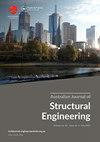Numerical calculation on the seismic performance of a steel frame beam-to-column joint with welding residual stress
IF 1.3
Q4 ENGINEERING, CIVIL
Australian Journal of Structural Engineering
Pub Date : 2022-04-03
DOI:10.1080/13287982.2021.2022448
引用次数: 1
Abstract
ABSTRACT Residual stress has almost always been an essential issue associated with welded structural steel. In this paper, thermal elastic–plastic finite element method (FEM) is adopted to calculate the welding residual stress of a steel frame beam-to-column, and then the calculated residual stress is applied to the subject as an initial condition to calculate its mechanical behaviour. Both monotonic loading and cyclic loading are designed to simulate the seismic behaviour of the structure. Bonora damage model [41–44] is used to calculate the initiation and propagation of the crack. Finally, the hysteretic curve of the structure under cyclic loading is obtained. The results show that the main component of the welding residual stress along weld fillers of the steel frame beam-to-column is longitudinal tensile stress, and the magnitude of the residual tensile stress in welding stable zone is about 1.2 times of the material yield stress. Welding residual stress mainly affects the ductility and fracture behaviour of the steel frame beam-to-column. Under monotonic loading, the drift ratio of crack initiation with welding residual stress is reduced by 9% compared with that without welding residual stress. Under cyclic loading, when welding residual stress is taken into account, the crack initiates a little earlier than when welding residual stress is not considered. Compared with monotonic loading, crack initiates much easier when the structure is subjected to cyclic loading.考虑焊接残余应力的钢框架梁柱节点抗震性能的数值计算
残余应力几乎一直是与焊接结构钢相关的一个基本问题。本文采用热弹塑性有限元法对某钢框架梁柱的焊接残余应力进行了计算,并将计算得到的残余应力作为初始条件应用于主体,计算其力学行为。设计了单调荷载和循环荷载来模拟结构的抗震性能。采用Bonora损伤模型[41-44]计算裂纹的起裂和扩展。最后,得到了结构在循环荷载作用下的滞回曲线。结果表明:钢框架沿焊缝填充物方向的焊接残余应力主要为纵向拉应力,焊接稳定区残余拉应力的大小约为材料屈服应力的1.2倍;焊接残余应力主要影响钢框架梁柱的延性和断裂性能。单调加载下,有焊接残余应力的裂纹萌生漂移比无焊接残余应力的裂纹萌生漂移比减小9%。在循环荷载作用下,考虑焊接残余应力时,裂纹产生时间略早于不考虑焊接残余应力时。与单调加载相比,结构在循环加载下更容易产生裂纹。
本文章由计算机程序翻译,如有差异,请以英文原文为准。
求助全文
约1分钟内获得全文
求助全文
来源期刊

Australian Journal of Structural Engineering
ENGINEERING, CIVIL-
CiteScore
2.50
自引率
0.00%
发文量
31
期刊介绍:
The Australian Journal of Structural Engineering (AJSE) is published under the auspices of the Structural College Board of Engineers Australia. It fulfils part of the Board''s mission for Continuing Professional Development. The journal also offers a means for exchange and interaction of scientific and professional issues and technical developments. The journal is open to members and non-members of Engineers Australia. Original papers on research and development (Technical Papers) and professional matters and achievements (Professional Papers) in all areas relevant to the science, art and practice of structural engineering are considered for possible publication. All papers and technical notes are peer-reviewed. The fundamental criterion for acceptance for publication is the intellectual and professional value of the contribution. Occasionally, papers previously published in essentially the same form elsewhere may be considered for publication. In this case acknowledgement to prior publication must be included in a footnote on page one of the manuscript. These papers are peer-reviewed as new submissions. The length of acceptable contributions typically should not exceed 4,000 to 5,000 word equivalents. Longer manuscripts may be considered at the discretion of the Editor. Technical Notes typically should not exceed about 1,000 word equivalents. Discussions on a Paper or Note published in the AJSE are welcomed. Discussions must address significant matters related to the content of a Paper or Technical Note and may include supplementary and critical comments and questions regarding content.
 求助内容:
求助内容: 应助结果提醒方式:
应助结果提醒方式:


